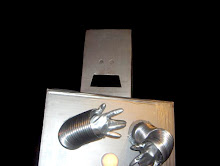 With great power comes great responsibility. Uncle Ben knew it. Spider man learned it. And now the fine people at Honda are geting a taste. Honda came up with a great viral advert that put a smile on people's faces, and it was paved over before I started typing.
With great power comes great responsibility. Uncle Ben knew it. Spider man learned it. And now the fine people at Honda are geting a taste. Honda came up with a great viral advert that put a smile on people's faces, and it was paved over before I started typing.Every highway driver knows what happens when you hit a rumble strip. A Japanese engineer accidentally figured out how to create musical tones through the frame of a car by controlling the width, depth and distance between lines scraped in asphault. Before you knew it, drivers in three Japanese cities were enjoying pop tunes while they commute.
Honda engineers used this technique to make a stretch of road in Lancaster, California to play the William Tell Overture. Drivers loved it, but local residents? It didn't take long for local officials to point out some issues.
The ultra dynamic trumpet-heavy, fully-orchestrated finale to Gioachino Rossini's William Tell Overture loses some lusture when reproduced on aspault. You have to drive at exactly 55mph to really get the effect. Any slower and you get a dull, sickening rumble. Any faster and it becomes a whacked-out, high pitched drone. If you're not driving a Honda Civic, the spacing of your axles will alter the effect. And the Japanese originators knew enough to make their roads far from people's homes. Evidentally in the wide open California desert land, the sound carries further than anticipated.
"When you hear it late at night, it will wake you up from a sound sleep," said Brian Robin, who lives a half mile away from Avenue K. "It's awakened my wife three or four times a night".
 Far be it for me to point out someone else's misfortune without pointing out my own. This piece was an invite for the very first agency I worked at. We needed an occassion, so we invented the two-and-a-half year anniversary party. The invite was simple enough; directions, two aspirin, and the suggestion that you would benefit from these the day after. The invites had to be crafted by hand and over 1,000 were mailed. Fast forward a couple of days, and the calls started. It turns out, mail does not gingerly flow on gentle breezes to their destinations like a scene from a Christmas cartoon. Real mail is beaten and rammed through sorting machines. Now picture the attached image with the dime bag, but instead of aspirin, you get white powder. The calls were endless. One was from Customs; summoning us, our lawyer and our checkbook to pay for testing, re-routing and charges related to sending controlled substances through the mail.
Far be it for me to point out someone else's misfortune without pointing out my own. This piece was an invite for the very first agency I worked at. We needed an occassion, so we invented the two-and-a-half year anniversary party. The invite was simple enough; directions, two aspirin, and the suggestion that you would benefit from these the day after. The invites had to be crafted by hand and over 1,000 were mailed. Fast forward a couple of days, and the calls started. It turns out, mail does not gingerly flow on gentle breezes to their destinations like a scene from a Christmas cartoon. Real mail is beaten and rammed through sorting machines. Now picture the attached image with the dime bag, but instead of aspirin, you get white powder. The calls were endless. One was from Customs; summoning us, our lawyer and our checkbook to pay for testing, re-routing and charges related to sending controlled substances through the mail. Somehow we had more than 1,300 people RSVP. We even had postal workers trying to crash the event. So the question is, are these campaigns really failures, or is the endless apologetic backpeddling just part of the cost of a great idea?








